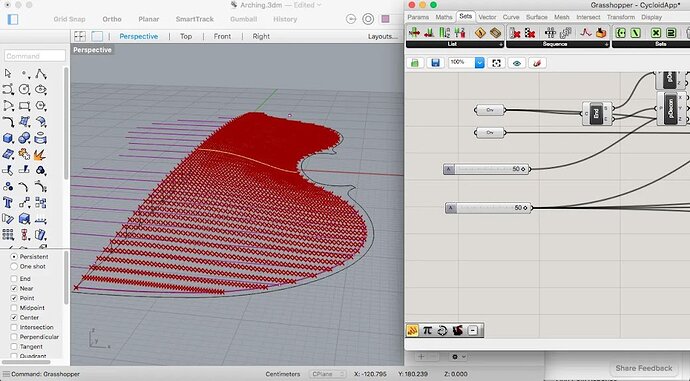Hello!
I saw on the Internet that violin piano board adopts grasshopper for parametric modeling, but I don’t know how to model it. I hope to get the detailed help of teachers, thank you!!!, By the way, attach a link to the web page.
To give you a start, here’s how I programed a unitary curtate cycloid in Grasshopper. It can be varied within the range from a straight line to a simple cycloid.
The C# inflection calculater had been posted by Dale Fugier in the forum.
UnitaryCurtateCycloid.gh (13.1 KB)
Then the height and width parameters can be referenced from Rhino curves or generated in Grasshopper.
Thank you very much for your guidance!!! What I’m confused about now is how to divide the height curve and width curve of the violin board equally. I asked some teachers, but they didn’t make progress. Can you spare valuable time to give detailed guidance? Thank you again.
First - disclaimers:
I’m only a few months into Grasshopper and Rhino, not strong in math and now in my 80’th year.
Feeling a bit shaky do not wish to publish detailed instructions of my solution. However, I am very enthusiastic about the potential of Rhino/Grass.
Here’s a basic verbal outline of my procedure:
In Grasshopper I used Divide Curve on the longitudinal centerline picked from Rhino.
Culled first and last points from the list. This list drives the program and also feeds directly into the longitudinal coordinate of each cycloid point.
LIST OF HEIGHTS AND LIST OF WIDTHS
From each division point, using Line SDL I drew lines of arbitrary length in the height and width planes.
Used Trim with Region to trim the two line sets with the corresponding curve.
Used Length on the two line sets to provide height and width lists for input to the cycloid generator.
To align the cycloids properly on height and width axes, the output from my cycloid generator required adjustment based on values from the height and width lists.
Here’s an output of curtate cycloids applied to an un-chamfered edge definition in Rhino and a centerline height curve defined in Grass. The inflection points are marked with green lines and the curve plotted:
Doug
Umm, not to bemoan anyone who put effort into some thing, but any modeling approach that consists of “I made 100 sections and lofted them” is utterly absurd and completely ignoring the principles of proper NURBS modeling. There is virtually no point in doing this thing this way other than as an exercise.
Thank you very much for your clarification. Thanks again!!!
As a long-time NURBS modeler, largely for boats, I share your reaction to seeing over-definition of a curve or surface. I also complain about slack or dull curves in design. Happily, I find user examples on the Rhino web site outstanding in that aspect.
I’ll invoke my 80th year disclaimer as an excuse for not foreseeing that my illustration could be taken as an example of good NURBS modeling so appreciate that you flagged it.
The two double bass examples above were not influenced by my example.
It was indeed, for me, a personal exercise and it killed two birds —advancing my understanding of Grasshopper and seeing for the first time a violin plate fully defined by cycloidal cross sections.
In particular, I wanted to see the flow of cycloid inflection points as the center height curve is modified. Ten or so section curves alone were sufficient for that. Then, wanting to push Grasshopper, I reset the number slider to hundreds. 200 became muddy. Lofting 100 sections was yet another "what-if” test of Grasshopper. Color seemed to improve the illustration so I kept it for the screen shot. This is as far as I wish to go with cycloids for violins at this time. I did cut several cycloidal templates to compare with my current plate carving.
Note re violin making: a proposal that curtate cycloids might have been used to design early violins has been floating around the violinmaking world but so far without much acceptance. Though every violin has somewhat similar S-shaped sections, I haven’t seen a close enough match to be convinced. Grasshopper enabled me to observe the implications of cycloidal sections with great precision.
By those who suggest that cycloids were used in early violins, how was it proposed they were generated as templates? It would seem that if you were to do it mechanically, you’d need a toothed wheel and rack to prevent slipping, especially on a small scale.
reading you are in your 80th year made me smile of joy
![]()
really enjoyed your investigation, congratulations! ![]()
Good observation. I haven’t tried it myself. Maybe rosin would help. Early violinmakers like Strad worked pretty loosely in comparison to modern manufacturing standards. However, the Antikythera mechanism shows gear teeth are pretty ancient.
!
If you don’t use it you loose it.
Hello! According to your prompt, I can operate the contour segment line correctly. However, the method of correctly aligning the cycloid on the height and width axis and inputting it into the cycloid generator is still unclear. Can you send an email to consult you? thank you!!!



